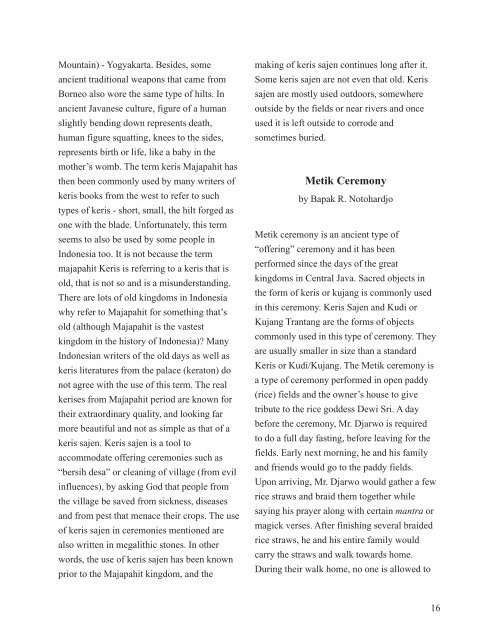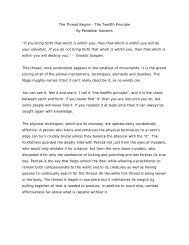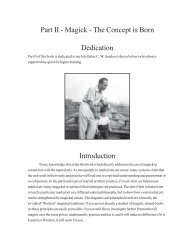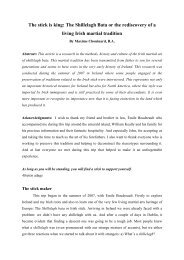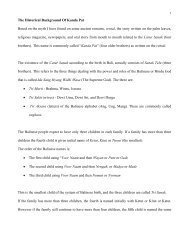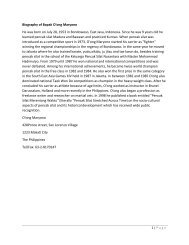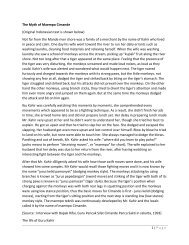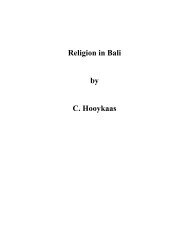Tenaga Dalam - Pukulan Cimande Pusaka
Tenaga Dalam - Pukulan Cimande Pusaka
Tenaga Dalam - Pukulan Cimande Pusaka
You also want an ePaper? Increase the reach of your titles
YUMPU automatically turns print PDFs into web optimized ePapers that Google loves.
Mountain) - Yogyakarta. Besides, some<br />
ancient traditional weapons that came from<br />
Borneo also wore the same type of hilts. In<br />
ancient Javanese culture, figure of a human<br />
slightly bending down represents death,<br />
human figure squatting, knees to the sides,<br />
represents birth or life, like a baby in the<br />
mother’s womb. The term keris Majapahit has<br />
then been commonly used by many writers of<br />
keris books from the west to refer to such<br />
types of keris - short, small, the hilt forged as<br />
one with the blade. Unfortunately, this term<br />
seems to also be used by some people in<br />
Indonesia too. It is not because the term<br />
majapahit Keris is referring to a keris that is<br />
old, that is not so and is a misunderstanding.<br />
There are lots of old kingdoms in Indonesia<br />
why refer to Majapahit for something that’s<br />
old (although Majapahit is the vastest<br />
kingdom in the history of Indonesia)? Many<br />
Indonesian writers of the old days as well as<br />
keris literatures from the palace (keraton) do<br />
not agree with the use of this term. The real<br />
kerises from Majapahit period are known for<br />
their extraordinary quality, and looking far<br />
more beautiful and not as simple as that of a<br />
keris sajen. Keris sajen is a tool to<br />
accommodate offering ceremonies such as<br />
“bersih desa” or cleaning of village (from evil<br />
influences), by asking God that people from<br />
the village be saved from sickness, diseases<br />
and from pest that menace their crops. The use<br />
of keris sajen in ceremonies mentioned are<br />
also written in megalithic stones. In other<br />
words, the use of keris sajen has been known<br />
prior to the Majapahit kingdom, and the<br />
making of keris sajen continues long after it.<br />
Some keris sajen are not even that old. Keris<br />
sajen are mostly used outdoors, somewhere<br />
outside by the fields or near rivers and once<br />
used it is left outside to corrode and<br />
sometimes buried.<br />
Metik Ceremony<br />
by Bapak R. Notohardjo<br />
Metik ceremony is an ancient type of<br />
“offering” ceremony and it has been<br />
performed since the days of the great<br />
kingdoms in Central Java. Sacred objects in<br />
the form of keris or kujang is commonly used<br />
in this ceremony. Keris Sajen and Kudi or<br />
Kujang Trantang are the forms of objects<br />
commonly used in this type of ceremony. They<br />
are usually smaller in size than a standard<br />
Keris or Kudi/Kujang. The Metik ceremony is<br />
a type of ceremony performed in open paddy<br />
(rice) fields and the owner’s house to give<br />
tribute to the rice goddess Dewi Sri. A day<br />
before the ceremony, Mr. Djarwo is required<br />
to do a full day fasting, before leaving for the<br />
fields. Early next morning, he and his family<br />
and friends would go to the paddy fields.<br />
Upon arriving, Mr. Djarwo would gather a few<br />
rice straws and braid them together while<br />
saying his prayer along with certain mantra or<br />
magick verses. After finishing several braided<br />
rice straws, he and his entire family would<br />
carry the straws and walk towards home.<br />
During their walk home, no one is allowed to<br />
16


